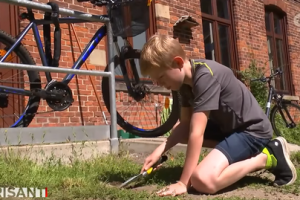Artefacts have always helped archaeologists and scholars to understand people and the times they lived in better. For example, the recently found 1,700 years old discarded worn out leather sandal in Horse Ice Patch in what is today’s Oppland, Norway provides fresh insights on how people in Iron Age travelled in that landscape, according to a report in smithsonianmag.com.
The footwear was noticed by a local hiker who snapped some images and passed its whereabouts to Secrets of the Ice, a glacial archaeology programme which is credited to have found ancient objects like the 1,300 years old wooden skis, a tunic which is 1,700 years old and many other such items in Norway’s ice and glaciers.
Fortunately, the hiker’s alert came in time as the researchers dug the shoe and other objects including arrow shafts, textiles and horse poop, following which the place got covered with fresh snow.
Radiocarbon dating of the shoe as per the Facebook of Secrets of the Ice, places the shoe around 300 CE. The sandal made of rawhide is size nine and as per Vegard Vike, an archaeological conservator at Oslo’s Kulturhistorisk Museum, it is in the style of the Roman carbatina which at that period was popular in Europe.
Commenting about this, Espen Finstad an archaeologist told Science Norway: “It’s pretty astonishing. [W]e’re up here at almost [6,500 feet], and we find a shoe with fashion elements similar to those found on the continent at the time. … It’s easy to joke about a Roman tourist who didn’t quite understand much about the country he was visiting.”
It is most likely that the wearer of these sandals used socks made of animal skin or fabric or wool wrappings to beat the cold. It was also discarded by the wearer after it had worn out. Secrets of the Ice archaeologist, Lars Pilø, said the shoe was probably not lost by the traveler. Instead, it must have been “thrown [it] away as rubbish” after it worn out.
The footwear of Roman design is one of the ancient objects that have been discovered by Secrets of the Ice on or near the Lendbreen pass in Norway’s Jotunheim Mountains because of melting of ice caused by warming of the planet. These include wooden tools, clothing, arrow and mummies. The finding of these objects show that Lendbreen pass was important in the travel route between the Roman Iron Age (around 300 C.E.) and the Middle Ages.
Also read: Portugal’s 8,000-year-old skeletons could be the oldest mummies on the planet
Commenting on this aspect, James Barrett, a University of Cambridge archaeologist who has studied Lendbreen pass said: “The pass was at its busiest during the Viking Age around 1000 [C.E.], a time of high mobility and growing trade across Scandinavia and Europe. This remarkable peak in use shows just how connected even a very remote location was to wider economic and demographic happenings.” Like this pass, the Horse Ice Patch was also a vital passage for travelers in ancient period and its trails linked inland Norway to the coast.
Talking about these travelers, Finstad said to Science Norway: “We imagine that people who travelled here would have had some sort of errand, a reason to move between these landscapes. They would have brought maybe leather, antlers, animal skins to the coast, and brought back salt and other goods.”




















